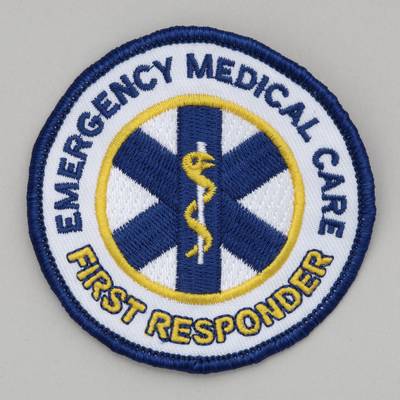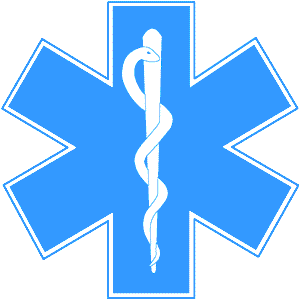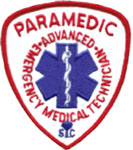Save a Life by Becoming a First Responder, EMT, or Paramedic
Prior to the advent of micro-electronics and radio communications, an ambulance was little more than an empty panel truck to transport an untreated patient to a distant hospital. Once hospital medical equipment could be miniaturized, and voice and data communication became possible from the field to hospital staff, an entirely new multi-level of emergency rescue services came into existence. In case you have not noticed this gradual change, the interiors of today’s ambulances look like emergency rooms on wheels that can now stabilize most patients in transit and avoid driving 90 miles per hour rushing to the hospital. In fact, these vehicles contain all of the life support equipment, patient monitoring systems, and medications found in any modern hospital emergency room. The people you see riding in today’s rescue vehicles have a very high level of emergency medical training, yet many are local volunteers, not paid medical staff.
In 1973, Congress passed the National Emergency Medical Services Systems Act which established national standards for all ambulances and ambulance equipment, and defined the emergency medical training required for ambulance personnel. Today, any person you see in a 911 rescue vehicle, including the driver, has several levels of formal emergency medical training.
 Levels of Training
Levels of Training
If you are interested in becoming the “medic” for your family or local community, the first thing you need to understand is that there are actually four recognized levels of volunteer medical training and certification. From basic to advanced skills, these are:
- First Responder
- EMT — Basic (EMT-B)
- EMT — Advanced (Cardiac)
- Paramedic
With the exception of Paramedic, which requires some college and in-hospital courses, the other three medical courses can be taken as evening classes at most local volunteer fire and rescue stations, and at some Red Cross offices and community col leges. Although these are not degree programs, you will hold a state license to practice and will be under both liability and injury insurance protection.
If you agree to volunteer several days per month after completing your training, most counties will pay all costs for you to attend these classes including books, uniforms, and on-call pager. Some students taking the First Responder and EMT courses plan to eventually become volunteer firemen, while others choose ambulance rescue. There are even special volunteer positions that accommodate persons with physical handicaps.
 First Responder: The First Responder is the most basic level of emergency training and is available at little or no cost. This training is usually given to a designated safety person at many businesses, schools, health clubs, and churches. It is assumed that this will be the first person on scene while waiting for an ambulance to arrive.
First Responder: The First Responder is the most basic level of emergency training and is available at little or no cost. This training is usually given to a designated safety person at many businesses, schools, health clubs, and churches. It is assumed that this will be the first person on scene while waiting for an ambulance to arrive.
You can learn the First Responder CPR procedures and the ABCs of initial patient assessment in a single 8 hour class. This is the starting point for working with any volunteer fire/rescue association and will be your first level of emergency medical training.
Human brain cells start dying 4 to 6 minutes after a person stops breathing and their heart stops beating, and clinical death usually occurs in 10 minutes. It should be obvious that it is difficult for emergency personnel to arrive this fast in many rural areas, and even limited medical assistance during those first few minutes prior to the arrival of a 911 team can significantly improve patient survival rates.
First Responder training teaches the ABCs of what needs to be done immediately to delay the onset of irreversible brain cell damage or death until advanced medical care arrives. Cardiac Pulmonary Resuscitation, or CPR, is an easy-tolearn medical procedure used to provide artificial breathing and manual heart blood pumping for a patient and is included in this ABC training:
- A—Airway: When most people suddenly become unconscious, their tongue will become extremely relaxed and settle back into their throat and block air flow to the lungs. Knowing how to simply reposition the victim’s head may correct this life threatening problem.
- B—Breathing: Falls, electrocution, near-drowning, and chocking can cause a person to stop breathing. If not corrected immediately, the heart will also stop beating soon after breathing stops. Providing temporary rescue breathing can keep the blood oxygenated and the heart pumping.
- C—Circulation: Circulation is the flow of blood throughout the body. If the body’s cells do not receive adequate blood flow, the body will soon shut down and go into shock. This can be the result of a heart attack, high blood loss from an injury, or drug overdose. CPR can maintain blood circulation when the heart stops beating until a defibrillator and advanced help arrives.
 Emergency Medical Technician— Basic (EMT-B): The next level of emergency medical training is the Emergency Medical Technician Basic, or EMT-B, which is the minimum level of training for all ambulance personnel.
Emergency Medical Technician— Basic (EMT-B): The next level of emergency medical training is the Emergency Medical Technician Basic, or EMT-B, which is the minimum level of training for all ambulance personnel.
The time it takes to complete the EMT-Basic program will vary depending on instructor and class hours per night, but will require taking between 140 and 180 hours of classroom instruction over a four to six months period.
At the end of these classes you will be required to take a written state exam at a regional testing center. The state testing also includes the completion of three different live “scenarios” requiring demonstration of patient assessment and treatment on a live patient in the presence of state certified instructors.
Stage makeup is used to make any “wounds” appear more realistic, and you are not told what the injury or medical problem is before entering the testing room.
- How to move a patient and scene size-up
- Spinal immobilization and back boarding
- Initial patient assessment and taking vital signs
- The “ABCs”: Airway, Breathing, Circulation
- Human body systems and general pharmacology
- Inserting oropharyngeal and nasopharyngeal airways
- Administering oxygen and patient suctioning
- Treating pediatric, adolescent, and geriatric patients
- How to apply bandages, splints, and head restraints
- Heart defibrillator operation and CPR techniques
- Respiratory and cardiac emergencies
- Diabetic and allergic emergencies
- Poisoning and overdose emergencies
- Snake and insect bite emergencies
- Treating smoke, fire, and chemical burns
- Obstetrics and gynecological emergencies
- Treating bleeding and shock emergencies
- Treating frostbite and near drowning
- Soft tissue and musculoskeletal injuries
- Treating head and spinal injuries
- Ambulance operation and safety
- Multiple casualty situations and car wrecks
I think you will agree it would be very useful for all of us to know how to administer these emergency treatments.
Modern building construction techniques and materials have significantly reduced the severity and frequency of structure fires, and over 75% of today’s 911 calls are for medical or accident emergencies, not fires. To respond to this changing trend, most state governments now require all firemen to complete the EMT-B level of emergency medical training. If you want to be a volunteer fireman, in many areas you will need to be an EMT-B first. Since being a fireman is high on the list of volunteer activities for many rural teenagers, it will not be unusual if many of your EMT-B classmates are still in high school.
Emergency Medical Technician— Advanced (EMT-Advanced): There are several add-on courses you can take after completing the EMT-Basic certification depending on your own interests and goals. These include advanced cardiac, helicopter rescue, rope rescue, vehicle extraction, water rescue, and wilderness rescue.
 Paramedic: The highest level of volunteer emergency medical training is the Paramedic. In most larger cities, at least one person on any three-person ambulance crew will be a Paramedic. Although not a medical doctor or nurse, a Paramedic has advanced emergency medical training and is licensed to administer drugs, intravenous infusions, perform emergency tracheotomies, intubations, and will know endless techniques to keep a person alive until they can reach a trauma center. Although you can also become a volunteer Paramedic, most Paramedics today are full-time paid positions due to the extensive training and constant retesting needed to maintain this certification.
Paramedic: The highest level of volunteer emergency medical training is the Paramedic. In most larger cities, at least one person on any three-person ambulance crew will be a Paramedic. Although not a medical doctor or nurse, a Paramedic has advanced emergency medical training and is licensed to administer drugs, intravenous infusions, perform emergency tracheotomies, intubations, and will know endless techniques to keep a person alive until they can reach a trauma center. Although you can also become a volunteer Paramedic, most Paramedics today are full-time paid positions due to the extensive training and constant retesting needed to maintain this certification.
Many rural counties and sparsely populated states cannot afford to have paid emergency ambulance personnel who have this advanced Paramedic level of emergency medical training, and will rely entirely on EMT-B volunteers for all emergency medical services.
Helpful References and Web Sites:
If you have teenagers wanting to help their community, I encourage you to let them participate in this emergency medical program. We know several students who took their training in high school, and continued to volunteer when they went away to college. This gave them a second home away from home, a maturity beyond their peers, and added piece of mind for their parents. If you are unable to donate some time with your volunteer fire/rescue squad, at least stop by the station to make a cash donation during their next fund raiser to buy a new ambulance, and be sure to take cookies.
Additional Research:
   |
Leave a Reply